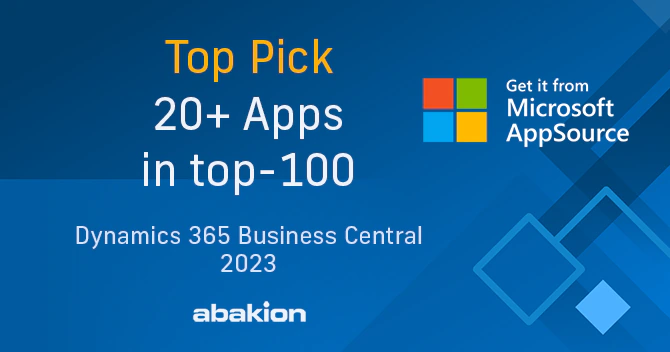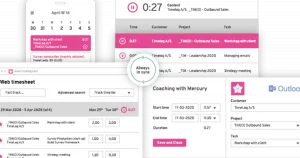Apps for Business Central
Abakion is a leading provider of APPS for Business Central. Among the top-100 most popular apps, 20+ are from Abakion.
We were among the first to develop Apps, and today we offer a comprehensive suite of 30+ apps on Microsoft AppSource.
Abakion is a one-stop shop for Apps.
App Bundle
Assign Quantity
Bring Shelfless 3PL Connector
Blue Water 3PL Connector
Commerce Manager
Created-by on Documents
Danske Fragtmænd 3PL Connector
Data Access for Business Central
Document Customizer
Document Handling
Duty Reporting
Dynamic Data Exchange
Ecommerce
Electronic Invoicing with Sproom
Financial Management
Flexible Forecast
Global Master Data Sync
Graphical Inventory Profile
Intercompany
Labels Mobile
Master Data Information
Production Order Cost Calculation
nShift Shipping Connector
Project Time Mobile
Purchase Container Handling
Purchase Order Management
Rejoose Connector
Rental Management
Reverse Planning
ROB-EX Scheduler Connector
Routing and BOM overview
Sales Configurator
Sales Container Handling
Search Items
YourGLS Shipping Connector
Shipmondo Shipping Connector
Shipping Manager
Shop Floor Mobile
Shortage on Demand Orders
Subscription Management
Tasklet Shipping Connector
TimeLog PSA
Use Dynamics
VAT Rate per Dimension
Warehouse Manager
Warehouse Mobile
Webshipper Shipping Connector
Try Apps for FREE
on AppSource
See the entire selection of Apps for Business Central on Microsoft AppSource.
Some are FREE – others come with a 30-days free trial.
This is all you need to know about Apps for Microsoft Dynamics 365 Business Central
We are going to talk about how to extend the functionality of Business Central by installing apps, instead of developing new functionality manually.
Apps are add-ons, or you could call them plugins, for Business Central, developed by partners and verified and published by Microsoft.
You are going to hear about:
- what the purpose of apps is,
- and how Apps actually work,
- which version of Business Central you need to be able to use apps,
- and we are also going to show you how to find the best apps to solve your needs
Let’s get started.
1. The purpose of Apps
Microsoft wants partners to develop a lot of additional functionality for Business Central. It can be functionality for a specific subject area, but it can also be complete industry solutions.
This means that Business Central can be used by many more different companies, and it expands the market for Business Central, and Microsoft is of course very interested in that.
So, Microsoft is happy with their partner network, and they would very much like to support their partners in developing apps.
In general, Microsoft’s purpose with Apps is to make it:
- easier for customers to get new functionality,
- easier for partners to provide add-ons to their customers,
- and easier for Microsoft to manage this entire ecosystem and make customers happy and satisfied.
Add-on solutions are nothing new
Some years ago, the solution was called Dynamics NAV, and in the old days Navision, and for many decades the Microsoft-partners have provided add-on solutions for customers.
So, it’s completely the same, just in a new setting.
It used to be more handheld, and now Microsoft has structured the entire setup by launching an app store called Microsoft AppSource.
Microsoft has several goals with this store:
- First, Microsoft wants more control over quality. Previously, the individual partner had to control the quality of their own solution, but today the add-on solutions are published in Microsoft’s own app store, and thus Microsoft has complete control over quality. They simply test and approve all apps before publishing them.
- Second, Microsoft also wants the popular add-on solutions to be available worldwide. In the past, a partner would market their solution in their own country, but today it’s easy to put an App for sale worldwide on Microsoft AppSource.
- And third, Microsoft wants to make sure that customers can use Apps from many different partners. This was difficult in the past, because it could create many conflicts if there were different partners who customized the code of the core solution. This has become much easier today.
You can use Apps from many different partners, and there is much less risk of them creating conflicts with each other.
It is also no longer the case that a customer only belongs to one partner. This was the case before, but today you, as a customer, can easily shop at many different suppliers.
What is an app really?
We must also talk a bit about the technology.
In the past, customizations were a huge task to maintain. If you’ve had Dynamics NAV or Navision in the old days, then you know that upgrade projects were incredibly expensive.
The reason for this was that the customizations were done directly in the code, and whenever a new version came out, it replaced your customizations. This was a mess.
With Apps, Microsoft has created a structure where the add-ons are placed outside the code, which means it’s much easier to maintain.
This is one of the main purposes of Microsoft introducing the concept of Apps.
Today, you can have a Business Central with a hundred apps installed, and when Microsoft rolls out a new version of Business Central, your solution is automatically updated, and so are your apps, and you do not have to do anything at all.
There is no maintenance for the customer. In fact, there are no version upgrade projects at all anymore.
That’s the main reason for using apps.
So, let’s look at how apps work in practice.
2. How Apps work
The cloud version of Business Central can be customized just as much as the on-premise version has always been able to. It’s just done in a different way.
Don’t worry, we’ll not dive too deep into technology, but it’s important that you understand the concept of how apps and customizations work in the cloud version of Business Central.
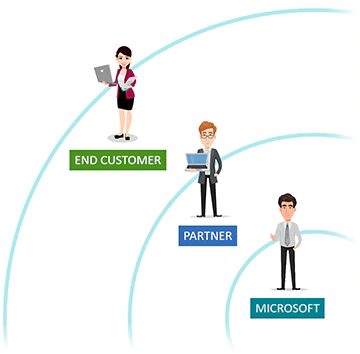
The traditional customizations
In the past. That is, before there were Apps for Business Central, if you wanted to customize the solution, you had to hire a consultant to develop the customization.
We can illustrate it like this.
Let’s say this is Business Central, and this is a line of code inside the Business Central solution.

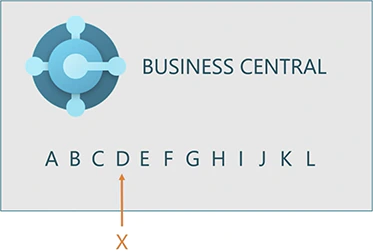
Now we want the solution to work in a different way. We want an X instead of a D in our code.
Traditionally, you would change the code directly in the core of Business Central. This is quick and efficient, but there’s just one problem.
Well, actually it’s a pretty big problem.
The problem with customizations
Occasionally Microsoft releases a new version of the core solution, and when they do, what do you think will happen?
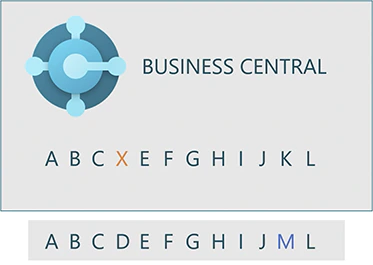
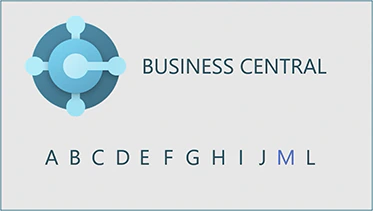
Yes, the new version replaces the change you made. It is gone.
You must manually review each and every customization and migrate them individually into the new version.
That is why upgrading has always been incredibly slow and expensive.
The concept of extensions
Today, everything has changed.
With Business Central in the cloud, you can expand the functionality with Apps, which are based on a technology that Microsoft calls “extensions”.
With an extension, you can place code outside of Business Central. It is an addition to the solution, not a change.

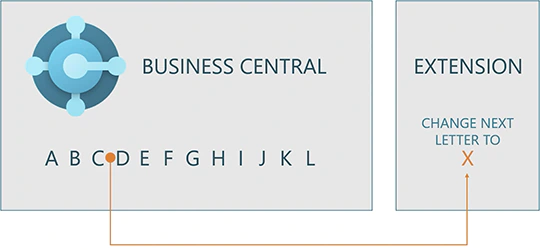
It utilizes “events” that Microsoft has placed within the core of the solution, enabling developers to trigger code when the “event” occurs, even though the code is outside the solution.
For the user, there is no difference. The end result is the same for the user.
But when Microsoft releases a new version of Business Central, there’s a huge difference: Your customization will not be overwritten.
New versions from Microsoft will not break your solution.
Your own custom extensions
This technology of adding to the code outside the solution – Microsoft calls it “extensions” – and when it is an extension that a supplier has developed only for your solution, and it is only installed in your solution, then it is called a “customer extension“.
You and your supplier have the responsibility for maintaining the “customer extension” and making sure it’s working when Microsoft releases new versions, but it’s a much smaller maintenance task when it comes to extensions – compared to the old way of customizing the core of the code.
Now we only have one step left, and that is to make an extension into an app.
When an extension becomes an app
If the supplier submits an extension to Microsoft AppSource, and Microsoft approves the quality, then it will be released on AppSource as an App, and then all Business Central customers worldwide can download and subscribe to the app.
The suppliers that get apps released on AppSource, they also commit to maintaining their apps.
This means that whenever Microsoft releases a new version of Business Central, the app supplier conducts a test in advance to make sure that their apps work, and they make sure to address any challenges with the new version.
As a result, customers rarely experience challenges with new versions. Most customers do not even notice that their Business Central is updated every month. It’s something that happens behind the scenes. It is not automatic, but it is no longer the customer’s task, and it is not something you have to pay extra for.
When to choose which
Now the good question is: when should you choose to use an app, and when should you rather get a consultant to develop a “customer extension”?
The choice between apps and custom development is an IT strategic decision and should be treated as such.
Custom development makes it easier to solve inflexible and extensive needs, while apps make it easier to launch new functionality quickly and upgrade to new versions.
Each method is best for its own thing. You just need to know which corner you are painting yourself into.
Enough said about technology. Now we’ll talk about which kind of Business Central can use apps at all.
3. Which edition is required?
There are several editions of Business Central. In terms of functionality, you can choose between Essentials and Premium, and they can both use apps.
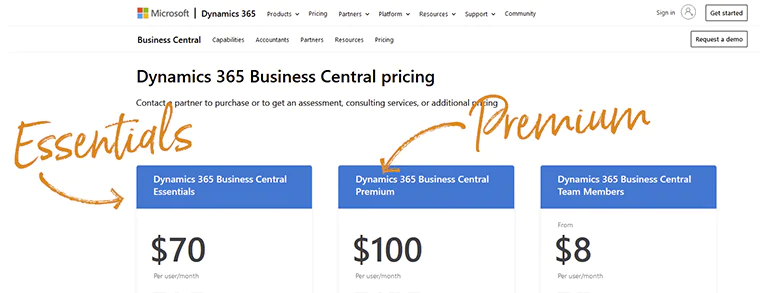
But at the technological level, there are also different editions, and they are all named Business Central. Microsoft has not given them different names, and to be honest, it’s a little confusing.
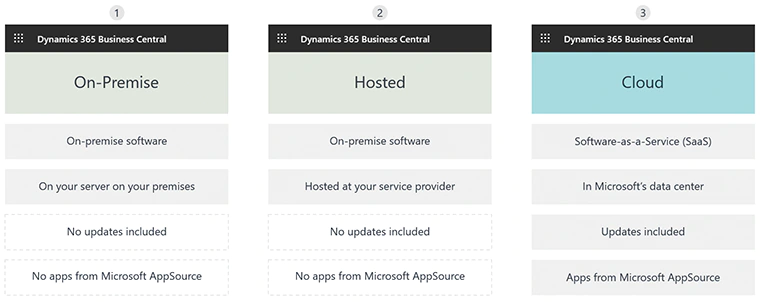
The traditional technology is called “on-premise“. If you want to learn the nerdy IT term, IT people often call it just “on-prem”. This means that you install your software license on your own server.
Traditionally, that server is located on your premises, hence the term “on-premise”, and you are responsible for maintaining it.
But you can also choose to install the software on a server in the cloud, for example on Microsoft Azure. This is usually called a “hosted” solution, but technically it is still an “on-premise” solution, because you have installed the solution yourself, and you have to maintain it yourself.
You can also buy a subscription from a provider who already has the hosted solution ready for you. If you’re in luck, the subscription also includes maintenance and upgrading of the solution. Then it feels a lot like a Cloud solution – but it is actually still an “on-premise” solution. You just pay a supplier to take care of all the practicalities.
And then we come to the most recent option, which is the Software-as-a-Service edition. That is the one that is usually called the “Cloud edition”.
This edition has been installed and is maintained by Microsoft, and it runs in Microsoft’s own data center. It’s genuine software-as-a-service, and that means you do not have your own software. You buy access to a solution that you share with a lot of other customers, but of course every customer can only see their own data.
The economies of scale of the Cloud solution makes it cheaper for you as a customer compared to what it would cost to maintain an on-premise edition yourself.
And then there is the important point that it is only on the Cloud edition that you can use Apps from Microsoft AppSource.
On the other editions you can install extensions, but it has to be done manually and they have to be maintained manually, and you can not just download apps from AppSource.
So, it is quite important which technical edition you have.
Choose wisely
Microsoft believes that the vast majority of companies should be on the cloud edition.
It’s only if you have very special requirements, or are subject to regulations, that an on-premise may be necessary. Beyond that, it’s mostly personal preferences and traditions that make companies choose on-premise. In terms of price, performance and security, the cloud edition wins.
4. How to find the right App
Finding the best apps on AppSource can be difficult. It’s a bit of a jungle. There are more than 2000 apps to choose from, and the number is increasing every day.
And let’s be honest: there are a lot of good apps, where you get a lot of value for your money, but there is also a lot of rubbish. But let’s look at some inside tricks to choosing the right app.
Three pricing models
The first thing you need to know is what the button texts really mean.
You have apps labelled “Free“, and on the button it says, “Get it now“, and it sounds like it’s free of charge, but that’s not always the case.

You may know it from your phone. The app is free to download, but if you need to use it for something, you must sign up for a subscription.
But there are actually many apps that are genuinely free, but unfortunately you cannot distinguish them from these fake free apps. It’s a shame.
For example, the app on the left is completely free, while the one on the right requires a subscription, but they are both categorized as “free”, and you cannot tell the difference until you read the details.

The second possibility is that it says, “Free trial“, and that is more accurate. Then you have access to try out the app for a period of time, so you can decide if you want to subscribe.

The third possibility is that it says, “Contact me“. This means that you cannot just download the app and use it. You must talk to the supplier first.
It may be an excellent app, but you can count on it requiring assistance from a consultant to use it. It’s probably not easy if it requires talking to a consultant first.
This may also be because the supplier is not very experienced in publishing apps on AppSource, and they would like to manually handle the installation to be on the safe side. Again, this should make you hesitate.
How to choose
So how do you choose the best app?
The only thing you can do is to search for your need, and to be thorough when you go through the options.
Here, as an example, we have searched for “demand planning”.
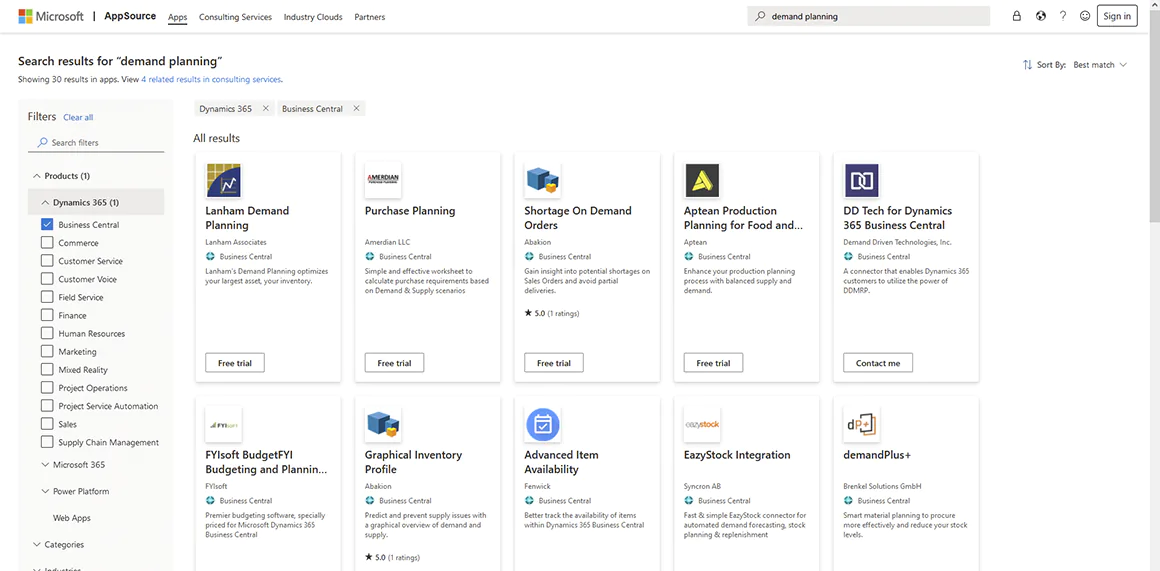
It returns several apps, and you can see that there are some apps that contain the specific expression in the title, and there are other apps that do not seem to hit the spot completely in relation to the need. But they are at least all (roughly) about the subject.
You can’t expect the most used apps to be first on the list. Nor the apps that have received the most or the best reviews. Unfortunately, Microsoft does not show how many customers use each app. It would be valuable information, because the count would probably be quite low on many apps.
The order mostly depends on how well your search term matches what the supplier has written about the app.
Still, there are some things you can do to evaluate apps against each other.
- It’s worth trying to ask your own Business Central supplier what apps they usually use. If they have used particular apps, then you should draw on their experience.
- You can also google the topic and see what comes out on the top, and you can try to find articles where consultants share which apps they prefer to use. There are some great recommendations to read if you are searching for a term like “best apps for [this topic] for business central”.
- Of course, you can also let yourself be guided by the stars and reviews customers have given on AppSource. There are not very many of them, but they can of course give you an indication.
- You should also look at how many apps the supplier has published in total. At the bottom of each app page, there are links to other apps from the same supplier. If you take the supplier’s name and search for it, you will get an overview of all apps from that supplier. If the supplier has released many apps, it’s a small indication that it’s a professional supplier who is used to servicing customers on apps.
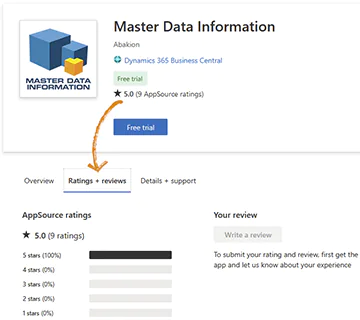
The most important thing, however, is to read the description of the app. See if it can do what you are looking for.
Get yourself an overall impression of whether the app seems professionally presented. Often it reveals the half-hearted products that they are not described well.
It is a requirement from Microsoft that there are at least 3 screenshots, so you cannot use that as an indication of quality.
But if the supplier has not bothered to write a proper text and produce some informative screenshots, then the quality of the app is probably at the same level.
You should also go to the supplier’s website and see if they have produced a high-quality web page about the app. If you cannot find more details, specifications, and screenshots, or maybe videos on the supplier’s website, then it’s a downside.
Look specifically for what help material is available. If there is a good manual or instructional videos about the app, then it is a good indication that the supplier focuses on quality and customer satisfaction.
We definitely recommend any app where you get thorough help material. It is absolutely the best advice on how to choose the right app.
Apps from multiple suppliers
If you enjoy using Apps in your Business Central, you will probably use apps from many different suppliers. And the good question is if that is a problem?
Is there a risk that apps from different suppliers will conflict with each other?
Yes, that risk exists, but it is not very big unless you install apps that have the same functionality, and there is no reason to do that.
Of course, the app-suppliers do not test their apps with all other available apps, so a small risk does exist.
You can mitigate this risk by doing three things:
- You can choose apps that are commonly used by many companies. However, AppSource does not show which apps are used the most, so this is actually difficult in practice.
- You can also choose to shop with as few suppliers as possible. For example, if you can use 5 apps from the same supplier, then you at least know that the 5 apps have been tested and work well together.
- But the most important thing is of course to test in the sandbox. If conflicts arise, then they probably show up quite early when you test your most common processes in the sandbox.
So, make sure to test. But beyond that, the risk of conflicts should not deter you from using apps.
Try Apps for FREE
on AppSource
See the entire selection of Apps for Business Central on Microsoft AppSource.
Some are FREE – others come with a 30-days free trial.
